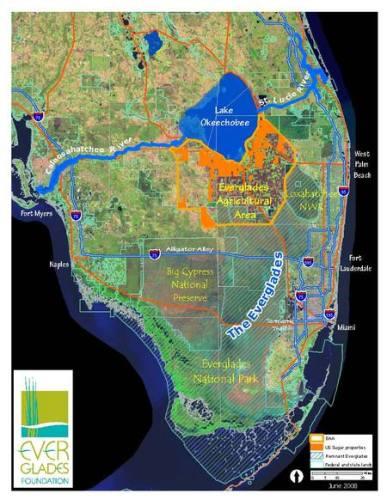In what's being called an unprecedented chapter in land conservation history, the state of Florida has agreed to buy 187,000 acres north of Everglades National Park and preserve the land to help ensure water flows into the park from Lake Okeechobee.
While the tentative $1.7 billion deal likely means the end of U.S. Sugar Corporation, a fact that deeply concerns the company’s workers (who technically own the company), it should prove invaluable to the national park. It will, figuratively speaking, straighten a kink in the natural plumbing of the region. It's been developments such as the sugar plantation that have disrupted natural water flows from the lake into the park. Without them, the so-called "River of Grass" can't survive.
"Today's announcement by Governor Crist to purchase approximately 187,000 acres of the Everglades agricultural area is terrific news for the future of Everglades restoration," says John Adornato, the National Park Conservation Association's regional director in Florida. "Securing farmland south of Lake Okeechobee will help improve water quantity and quality, and increase water flow to Everglades National Park and out into Florida Bay."
It's somewhat ironic that the purchase was announced today, just hours after the NPCA released a new report highlighting threats to the National Park System. One of the most significant threats pointed out by NPCA Senior Vice President Ron Tipton is how lands adjacent to national parks are managed. While there's no single solution to addressing that issue, today's announcement from Florida is a prime example of one of the solutions that can be achieved.
In an ecosystem dependent on water, the importance of the U.S. Sugar deal can't be understated. Under the agreement, the sugar company will remain on the property for six more years and then turn the land over to the state of Florida, which will preserve it.
Florida Governor Charlie Crist called the agreement "as monumental as the creation of our nation's first national park, Yellowstone."
"This represents, if we're successful and I believe we will be, the largest conservation purchase in the history of the state of Florida," the governor added.
Robert Buker, president and CEO of U.S. Sugar, dubbed the deal a landmark in the nation's conservation history.
"I am mindful that events like this lend themselves to rhetorical excess, a vice I normally resist. But I do not think the importance of what we are announcing today can be overstated," said Mr. Buker. "This is a watershed event in national conservation history, and a paradigm shift for the Everglades and the environment in Florida, one that would have been inconceivable in years past."
Officials at the Everglades Foundation hailed the purchase agreement as "a once-in-a-generation opportunity that will move Everglades restoration forward beyond all expectations.”
Scientists with the foundation said the agreement has the dual benefit of protecting the St. Lucie and Caloosahatchee estuaries from damaging freshwater releases while providing an enormous supply of clean water, the lifeblood of the Everglades, to sustain those fragile wetlands during droughts.
“The significance of this cannot be overstated,” said Everglades Foundation Senior Scientist Dr. Tom Van Lent. “This acquisition will provide the land needed to construct a reliable water supply for the Everglades much faster and at a lower cost than previously envisioned. It will allow us to eliminate about 85 percent of the damaging releases to the St. Lucie and Caloosahatchee, and it will do so decades earlier than we thought possible.”
Back at the NPCA, Mr. Adornato said the agreement should "lead to increased capacity for cleaning polluted water, storing excess rainwater, and recreating the historic timing of water delivery from Lake Okeechobee to the Everglades. Additional storage will alleviate drought concerns about removing levees and elevating Tamiami Trail."
At the same time, he said the federal government needs to step up with support and funding to invigorate efforts to restore the Everglades. Those plans, established in 2000 and known as the Comprehensive Everglades Restoration Plan, are viewed as the most ambitious ecosystem restoration effort anywhere in the world. Yet while the state of Florida and the federal government signed on as equal partners in the project, the federal government has provided far less than the more than $2 billion the state has committed.
"Restoring the health of the Everglades is not only vital to our environment, but our economy and quality of life here in South Florida. We must leave a legacy for our children and grandchildren by saving one of the great special places in the world-America's Everglades," he said.


 Support Essential Coverage of Essential Places
Support Essential Coverage of Essential Places







Comments
This is absolute wonderful news, probably the most significant environment preservation action of the year, if not the last ten years.
It's not without economic impact: between the loss of jobs at U.S. Sugar, the debt load on the State of Florida, and the possible increase in the price of sugar due to reduced production, this is not an easy, cheap fix.
However, based on the health of the Everglades, and possibly the health of water tables throughout South Florida (witness the historic low levels of Lake Okeechobee), it's money well spent.
=================================================
My travels through the National Park System: americaincontext.com